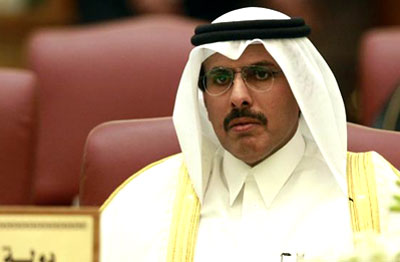
Qatar cenbank 'will flexibly adjust debt issues'
Doha, April 23, 2013
Qatar's central bank (QCB) will if needed flexibly adjust the amounts of local currency bonds and Treasury bills which it offers, and believes the issues will reduce Qatar's reliance on foreign funding, the QCB's governor said.
The QCB launched quarterly issues of riyal-denominated bonds in March, giving it a tool to manage excess liquidity in the banking sector as the economy gears up for heavy infrastructure spending in the next few years.
"As of now, we plan to issue the same amounts in every quarter. Cumulatively, that would imply total issuances of QR16 billion ($4.4 billion) during the year," Sheikh Abdullah bin Saud al-Thani said in written answers to questions from Reuters.
"We, however, would continue to keep a close watch on the evolving domestic and global developments and would react accordingly, if required."
In March, the central bank placed QR1 billion of Islamic bonds and 3 billion riyals of conventional bonds, half with three-year maturities and half with five-year, directly with local banks.
In addition, the central bank has been holding monthly auctions of 91-, 182- and 273-day Treasury bills since 2011. The volume of funds drained through this tool has stayed in recent months at QR4 billion per month, despite a build-up in surplus liquidity in the banking system.
"As of now, we intend to continue with the Treasury bill auctions of the same amount as done hitherto. As mentioned before, we would take stock of the evolving situation in future and react flexibly if there is any need to change the current practice," Sheikh Abdullah said.
A more active monetary policy may be needed in coming years as Qatar plans to spend some $140 billion on infrastructure building, partly in preparation to host the 2022 World Cup soccer tournament.
In the wake of the 2011 interventions in the money market, total available liquidity dropped to a mere QR5.8 billion at the end of that year from QR73.2 billion a year earlier, the QCB has said.
But excess liquidity has begun building again. Funds parked by banks at the central bank's low-yielding deposit facility hit a two-year high of 204 billion riyals in January this year, though they subsequently fell back to QR138 billion in February, the latest QCB data show.
Loose liquidity pushed the average three-month interbank lending rate down to 0.76 per cent in November, the lowest since June 2011. It rose again to 1.03 per cent in February but is still well below the March 2012 peak of 1.75 per cent.
In January, the International Monetary Fund said Qatar's central bank needed to start managing liquidity fluctuations more finely through more flexible open market operations.
Asked if the QCB planned to launch a reverse repo instrument to absorb liquidity in case of short-term fluctuations, as the IMF recommended, Sheikh Abdullah said there were not enough government securities outstanding at present to use such an instrument in a sustained manner.
"As of now, we are not contemplating the introduction of reverse repo in the immediate future...Since the QCB does not finance the government by purchasing government bonds in the primary market, there is little scope of enhancing its stock of securities substantially in the near future," he said.
"Therefore, the QCB is operationally constrained to move towards the introduction of reverse repo at the present juncture."
The new bond issue programme will, however, deepen the local debt market in the long term. Asked whether domestic bond issues meant Qatar would be less active in issuing U.S. dollar-denominated sovereign bonds, Sheikh Abdullah said: "A local debt market would enhance options for domestic financing and reduce reliance on foreign funding." He did not elaborate.
Qatari Finance and Economy Minister Youssef Kamal said earlier in April that the country was still open to conducting debt issues in the international market, depending on opportunities and on the level of debt to gross domestic product, which is very low.
The Qatar government was last in the international debt market in July 2012 with a $4 billion dual-tranche sukuk issue, which attracted orders worth over $25 billion.-Reuters







